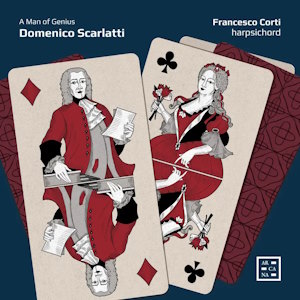
Domenico Scarlatti (1685-1757)
A Man of Genius
Sonatas 1752-1753
Contents listed after review
Francesco Corti (harpsichord)
rec. 2023, François-Lang Music Library of the Royaumont Foundation, Asnières-sur-Oise, France
Arcana A568 [86]
Francesco Corti has selected sixteen sonatas by Domenico Scarlatti that were copied between 1752 and 1753 into volumes held in Venice and Parma. The album, A Man of Genius, showcases how Scarlatti stretched the sonata form and elaborated upon thematic material. Virtuosity and formal freedom characterise the sonatas included on the present disc and give each one an individual profile, which is remarkable given the sheer quantity, 555, attributed to the composer. These sonatas exhibit a mature compositional style, even though the lack of holographs makes it difficult to ascertain when Scarlatti wrote them.
Scarlatti composed the sonatas for himself and his pupil, Maria Bárbara de Bragança, a Portuguese infanta and, as the wife of Ferdinand VI, Queen of Spain from 1746 until her death in 1758. The sonatas have several motifs in their first parts, which often recur in their second parts, and the dense harmonic texture sometimes leads into distant keys. The Essercizi of 1739 and a few other sonatas published during Scarlatti’s lifetime established his reputation. No autographs have survived for the unpublished sonatas, but copies were compiled in various volumes from 1742 and 1749 to 1757. The most important collection of manuscripts is in the Biblioteca Nazionale Marciana in Venice (496 sonatas in 15 volumes). Other manuscripts are in the Biblioteca Palatina in Parma (463 sonatas), the Universitäts- und Landesbibliothek Münster (349 sonatas), and the Archiv, Bibliothek und Sammlungen der Gesellschaft der Musikfreunde in Vienna (308 sonatas).
Ralph Kirkpatrick was the first to observe that in the volumes of Venice and Parma from 1749 onwards, two sonatas in the same key almost always follow each other or that they differ only in the mode. He also noted extensive similarities between the two manuscript collections (and in some cases other sources). This recording uses Kirkpatrick’s catalogue (abbreviated to K), which is based on the dates of the copies and the few published sonatas. The sonatas featured here are organised in pairs according to the binary ordering from the Venice and Parma manuscripts.
Corti treats these sonatas as having expressive character, so that they emerge as much more than the virtuosic encore pieces for pianists, but as music that demands concentration. Corti’s insight and nuanced phrasing make these performances compelling and varied in spite of the similar structure the sonatas share. The current album, hopefully, marks the beginning of what will become a cycle that shows each sonata’s capacity to enthral when performed at the level in evidence here.
The opening pair of sonatas, K 213 and 214, offer contrast by going from D minor to major and juxtaposing pensiveness with vivacity. In the next couple, K 208 and 209, the first is an ‘Adagio e cantabile’, i.e., it should have a singing quality, an effect that is not easy to achieve on a harpsichord. With subtle ornamentation, Corti emulates a vocal-like melodic line. Both of the sonatas, K 248 and 249, are marked ‘Allegro’ and require virtuosity, including sudden shifts of the hands. A journey from serenity through tempestuousness characterises the pair, K 215 and 216, and shows that the development of a Scarlatti sonata cannot always be anticipated based on the opening theme. The A-Minor sonatas, K 217 and 218, move from ‘Andante’ to ‘Vivo’, while the C-Major pairing, K 242 and 243, goes from ‘Vivo’ to ‘Allegro’. The final two couplings, K 244/245 and K 219/220, show how Scarlatti combined structural clarity with stylistic variety, a suitable end to a disc intended to demonstrate the composer’s ‘genius’.
Those unfamiliar with Scarlatti’s musical language, which earned the respect of no less a figure than George Frideric Handel, will find themselves rewarded by starting with Corti. I was impressed by how Corti emphasises the compositional liberty that Scarlatti represents as an experimenter, who arguably made the multi-movement sonatas by Joseph Haydn and Wolfgang Amadeus Mozart possible. Scarlatti composed less contrapuntally than his exact contemporaries, Handel and Johann Sebastian Bach, and was, thus, freer in form and content.
An important factor in the success of this recording is the beautiful sound of the harpsichord that Philippe Humeau built in 2002 ‘after Italian models’ (pitch: a’ = 415 Hz). This warm, resonant instrument produces none of the harshness often associated with harpsichords during long listening sessions. Detailed, intimate recorded sound offers a comfortable listening experience for the programme’s generous 86-minute duration. Lovers of Scarlatti and eighteenth-century keyboard music generally should not miss this disc.
Daniel Floyd
Buying this recording via a link below generates revenue for MWI, which helps the site remain free



Contents
Sonata in D Minor, K. 213. Andante 8:34
Sonata in D Major, K. 214. Allegro vivo 3:35
Sonata in A Major, K. 208. Adagio e cantabile 4:43
Sonata in A Major, K. 209. Allegro 4:44
Sonata in B-Flat Major, K. 248. Allegro 5:12
Sonata in B-Flat Major; K. 249. Allegro 5:15
Sonata in E Major, K. 215. Andante 7:40
Sonata in E Major, K. 216. Allegro 5:31
Sonata in A Minor, K. 217. Andante 11:20
Sonata in A Minor, K. 218. Vivo 2:39
Sonata in C Major, K. 242. Vivo 3:52
Sonata in C Major; K. 243. Allegro 3:36
Sonata in B Major, K. 244. Allegro 5:25
Sonata in B Major, K. 245. Allegro 3:50
Sonata in A Major, K. 219. Andante 5:26
Sonata in A Major, K. 220. Allegro 4:52

















